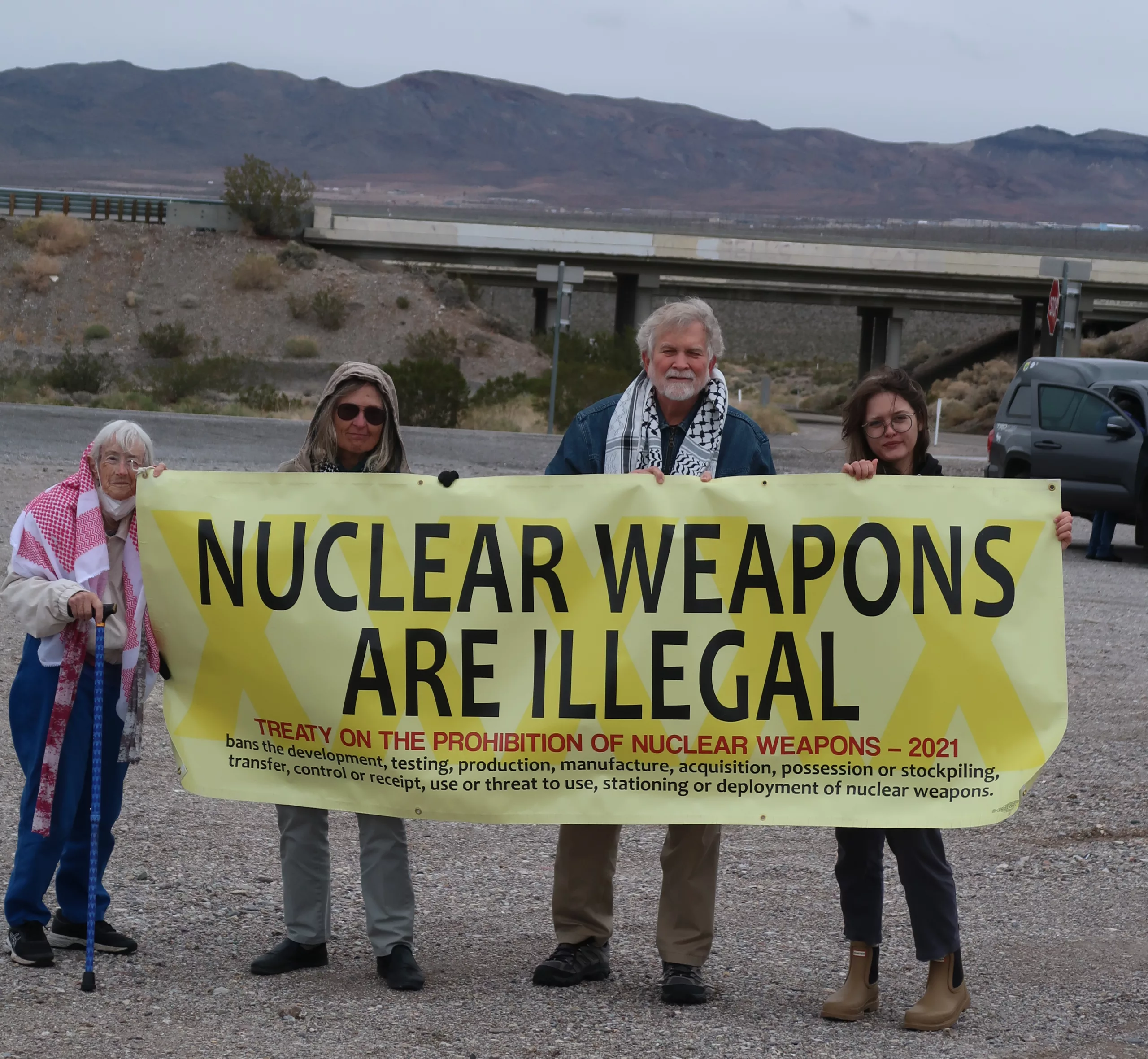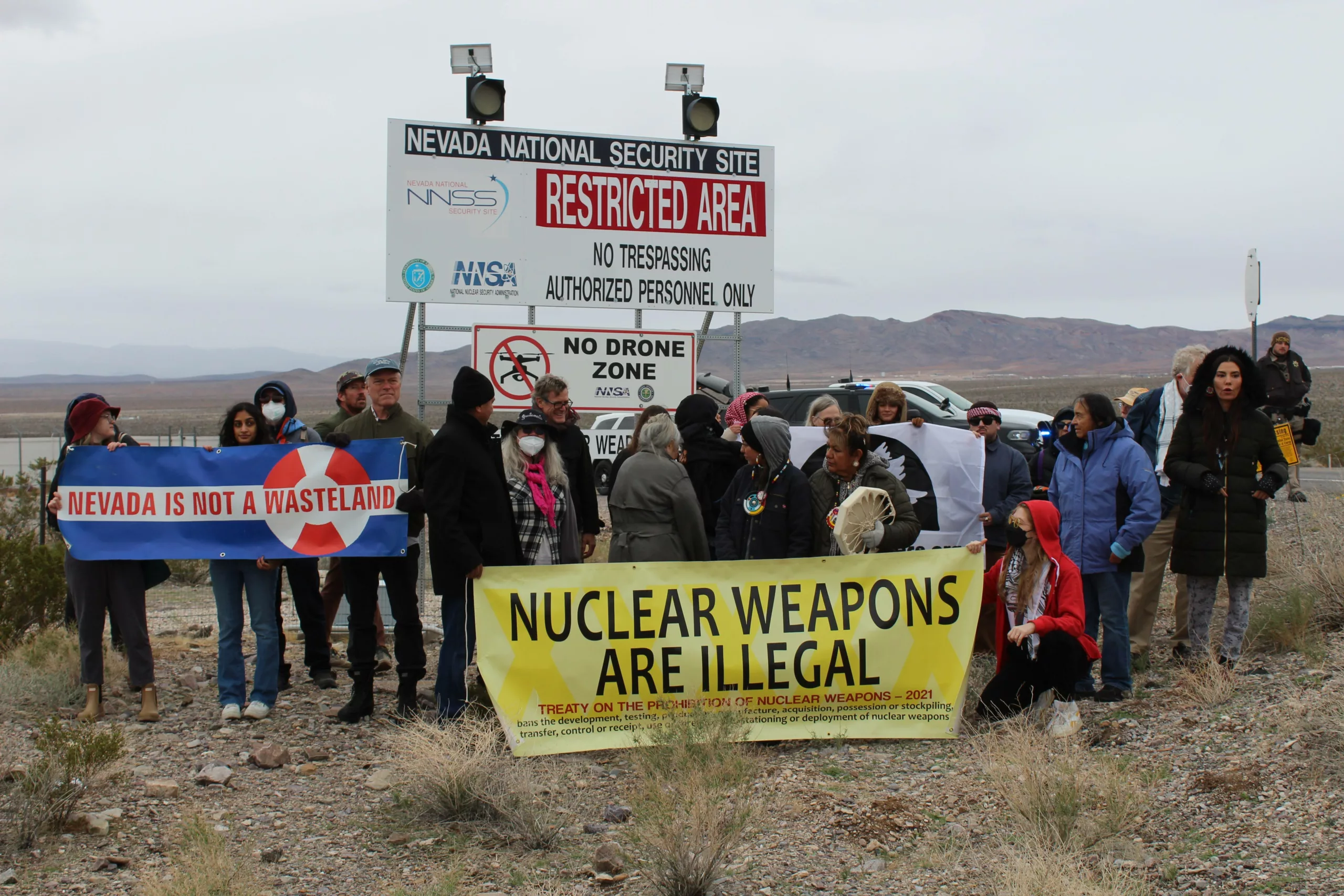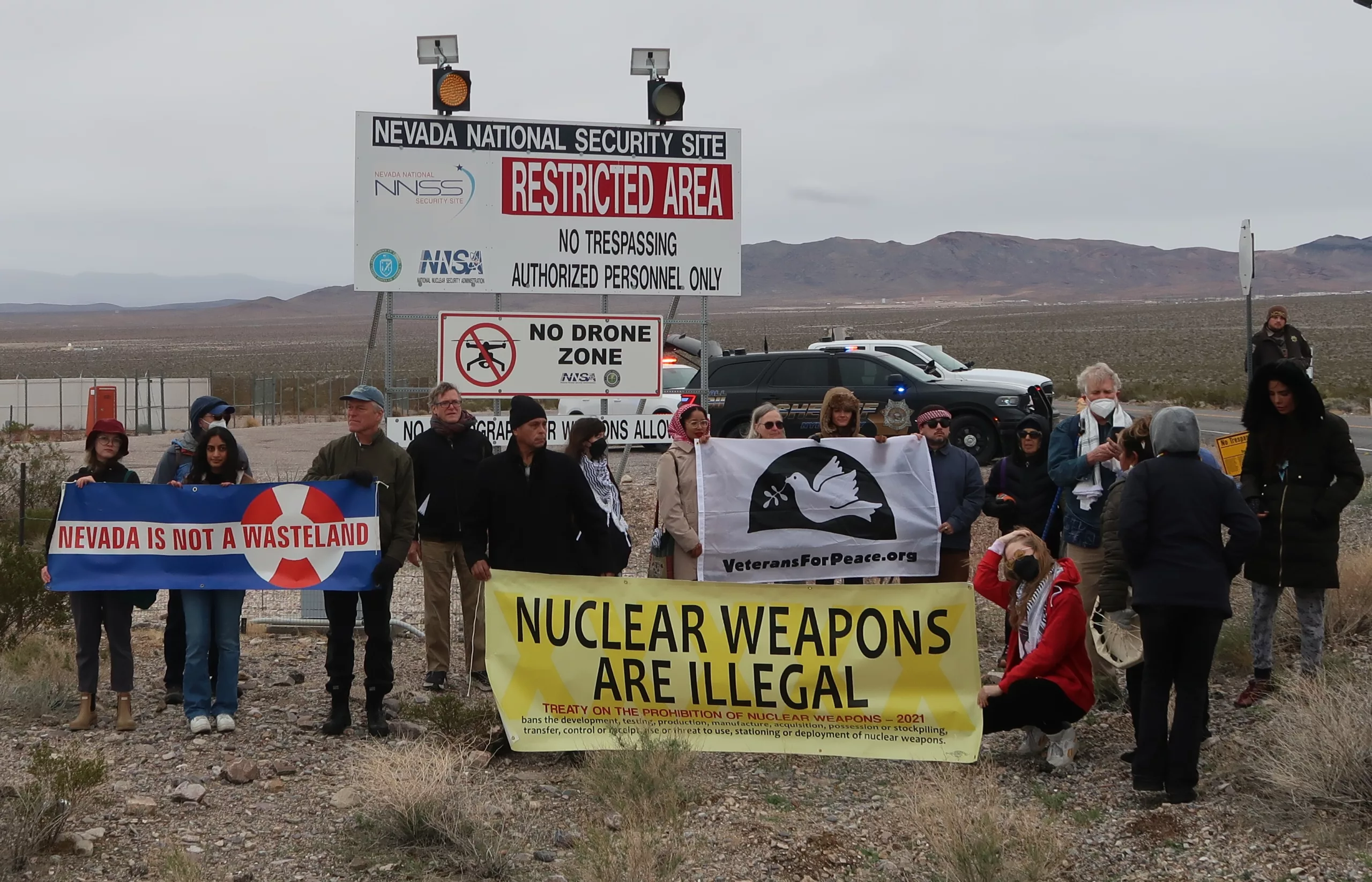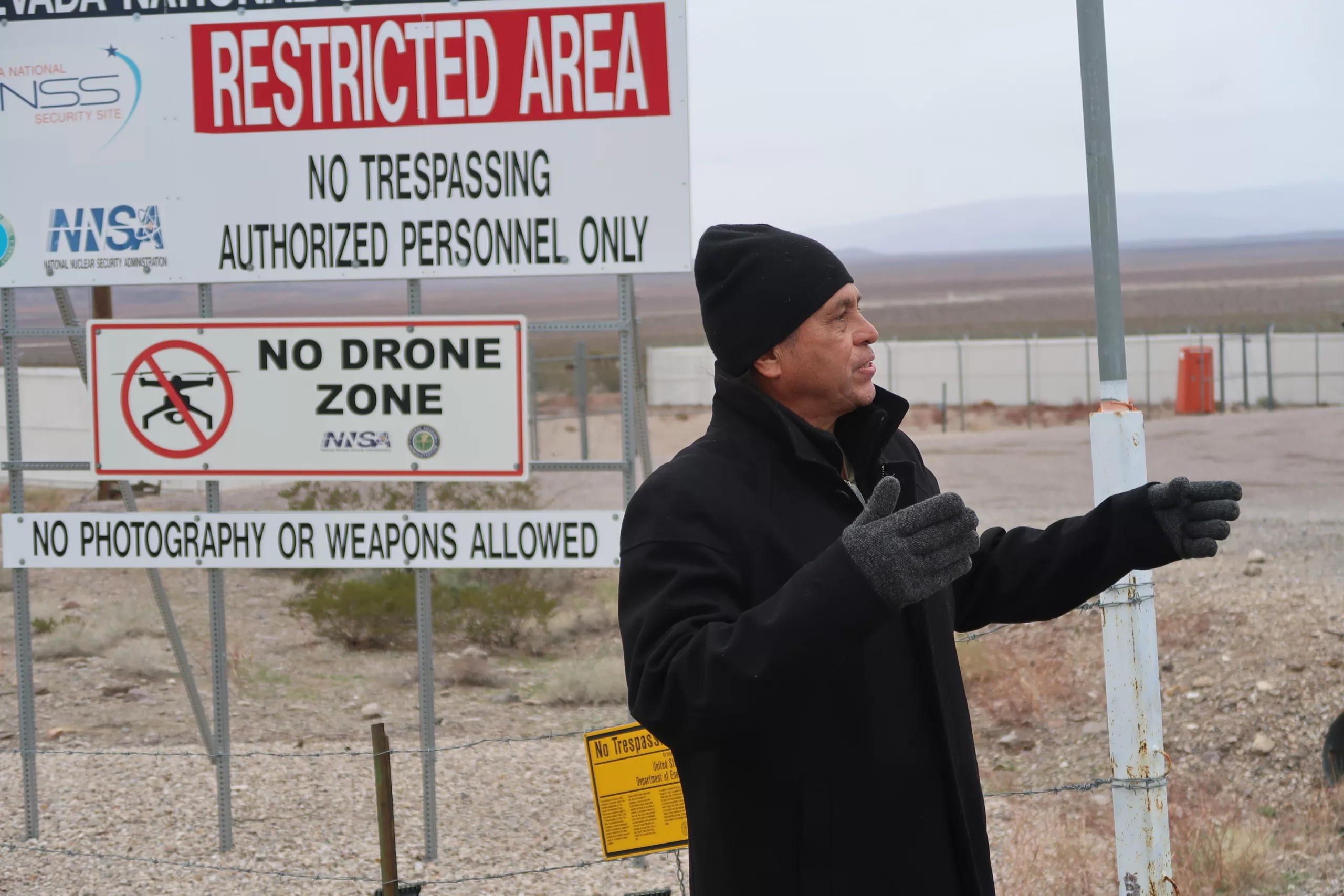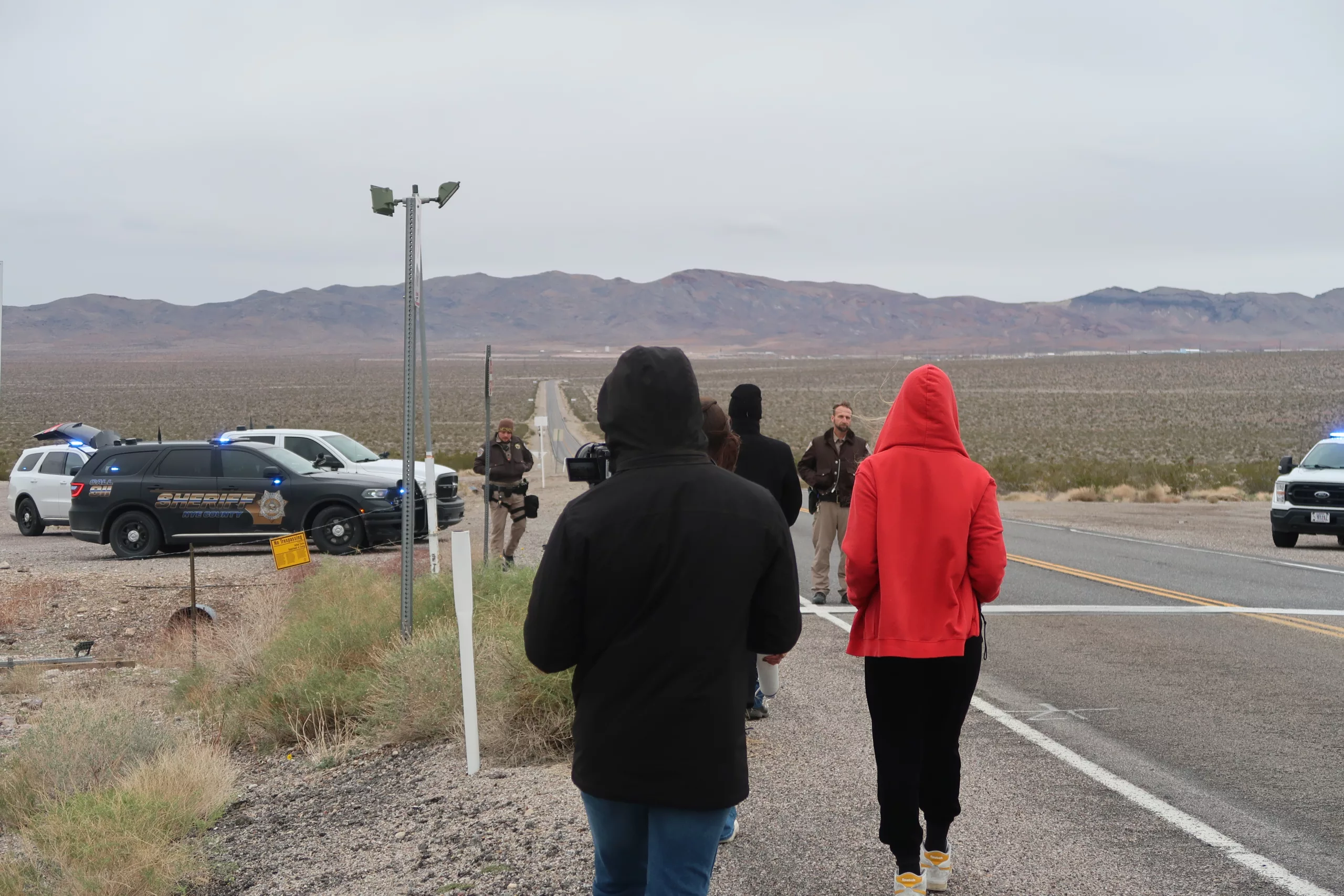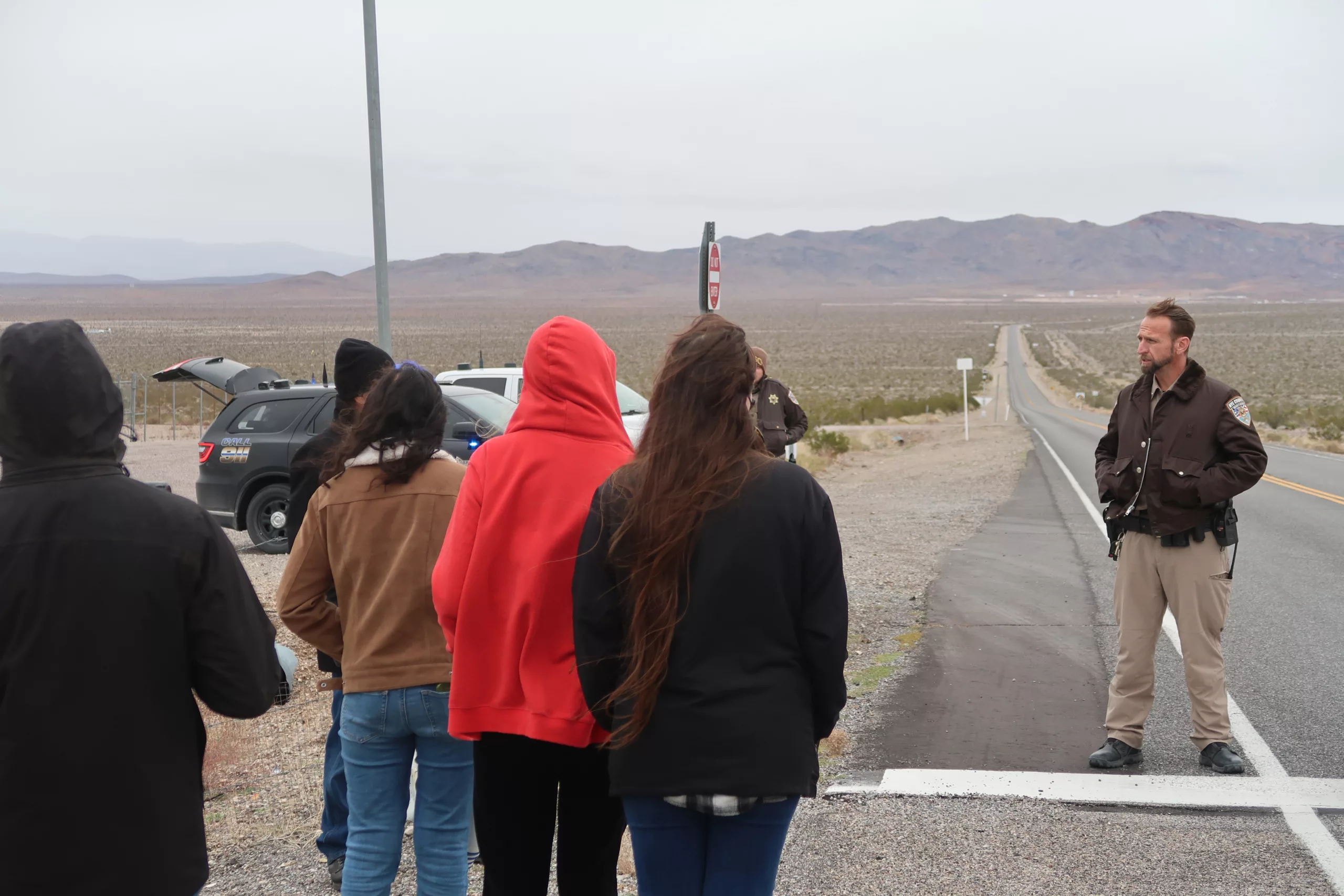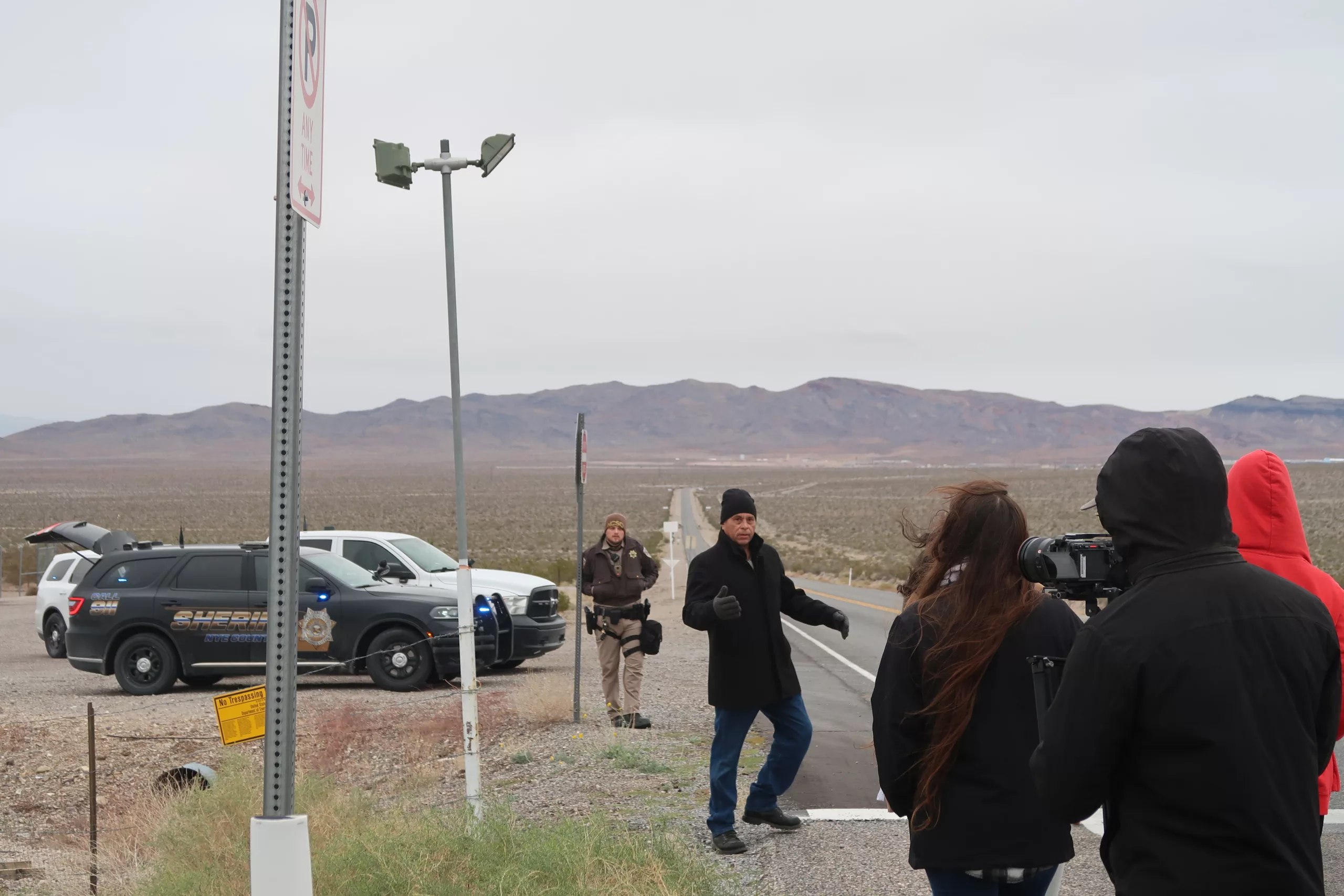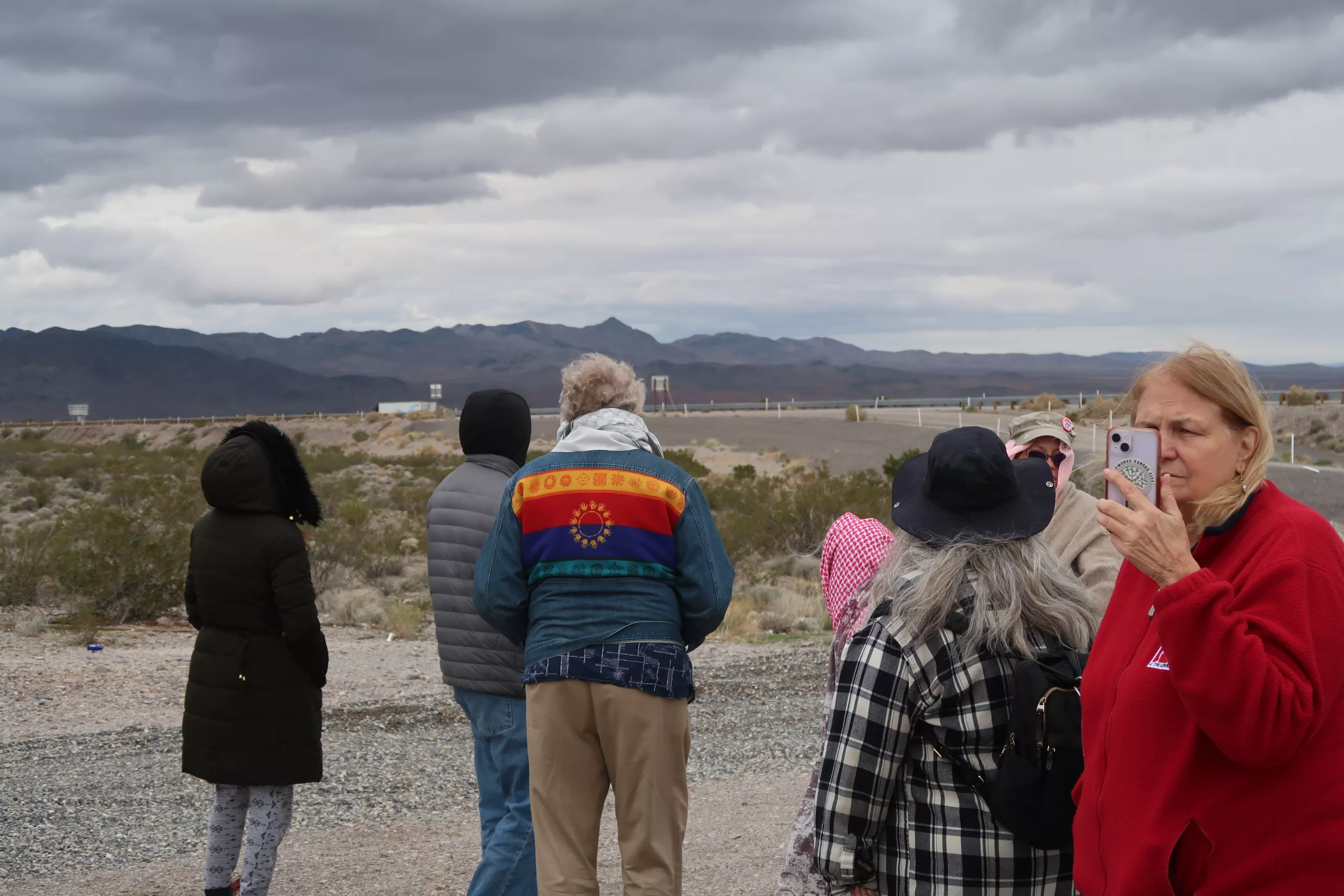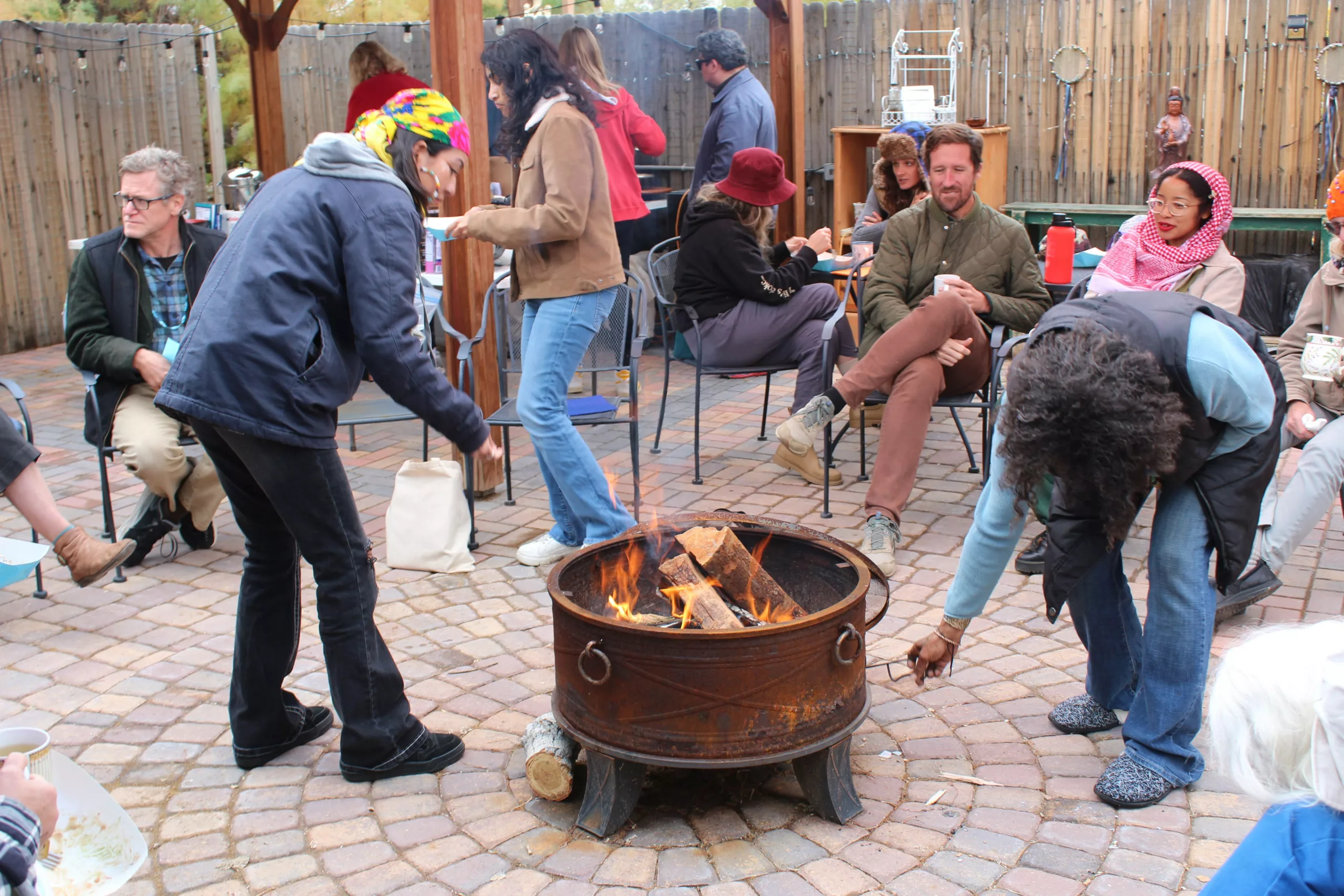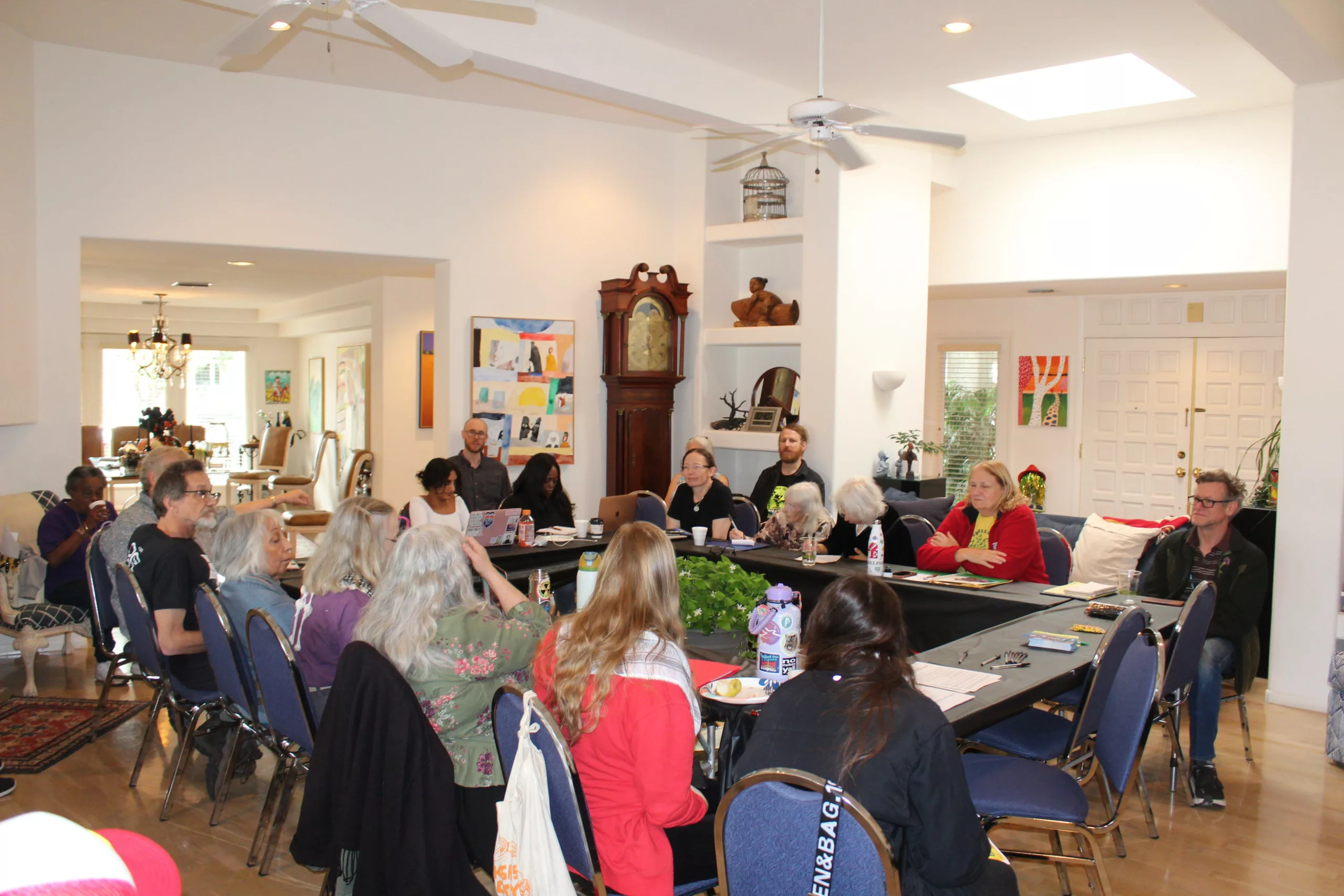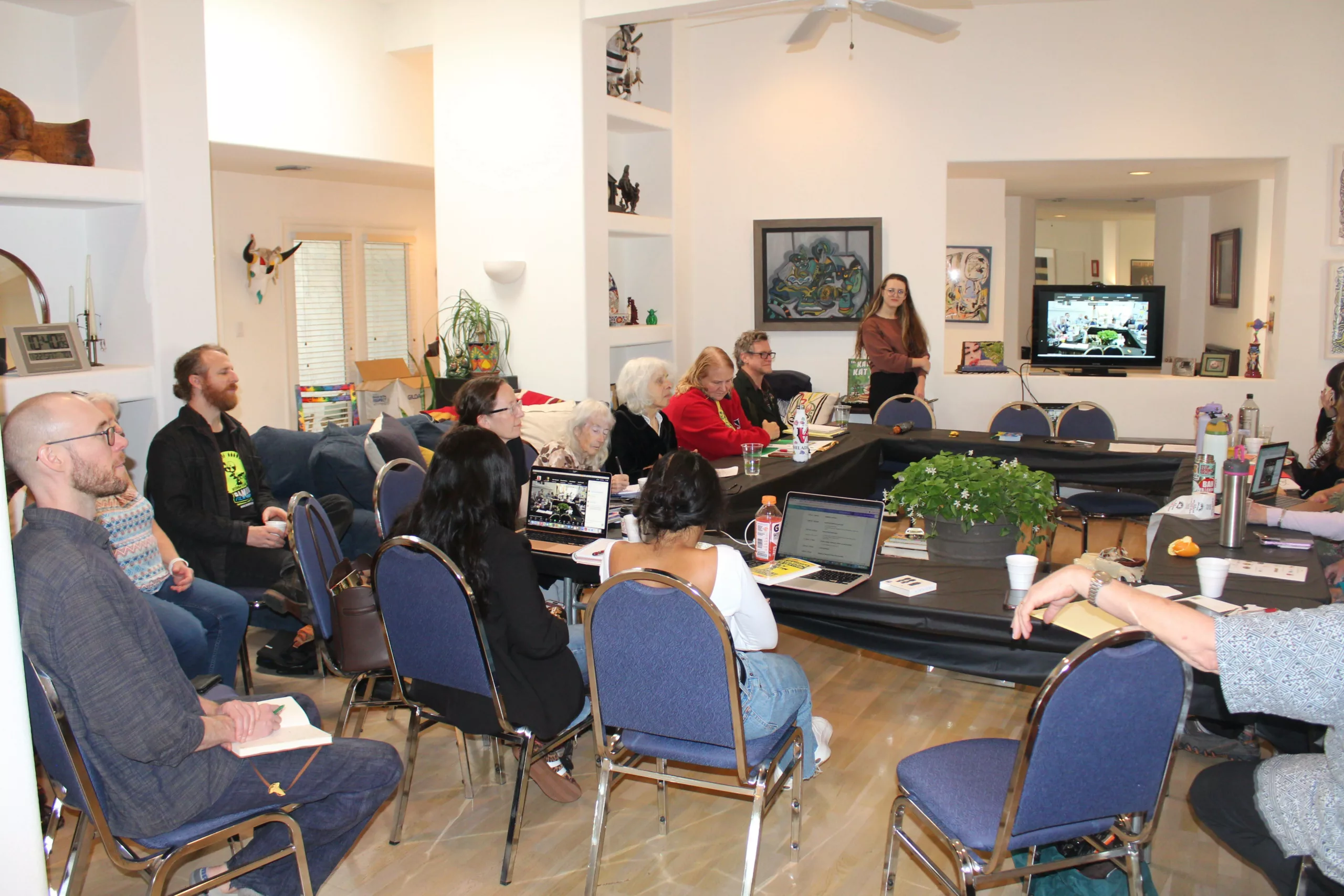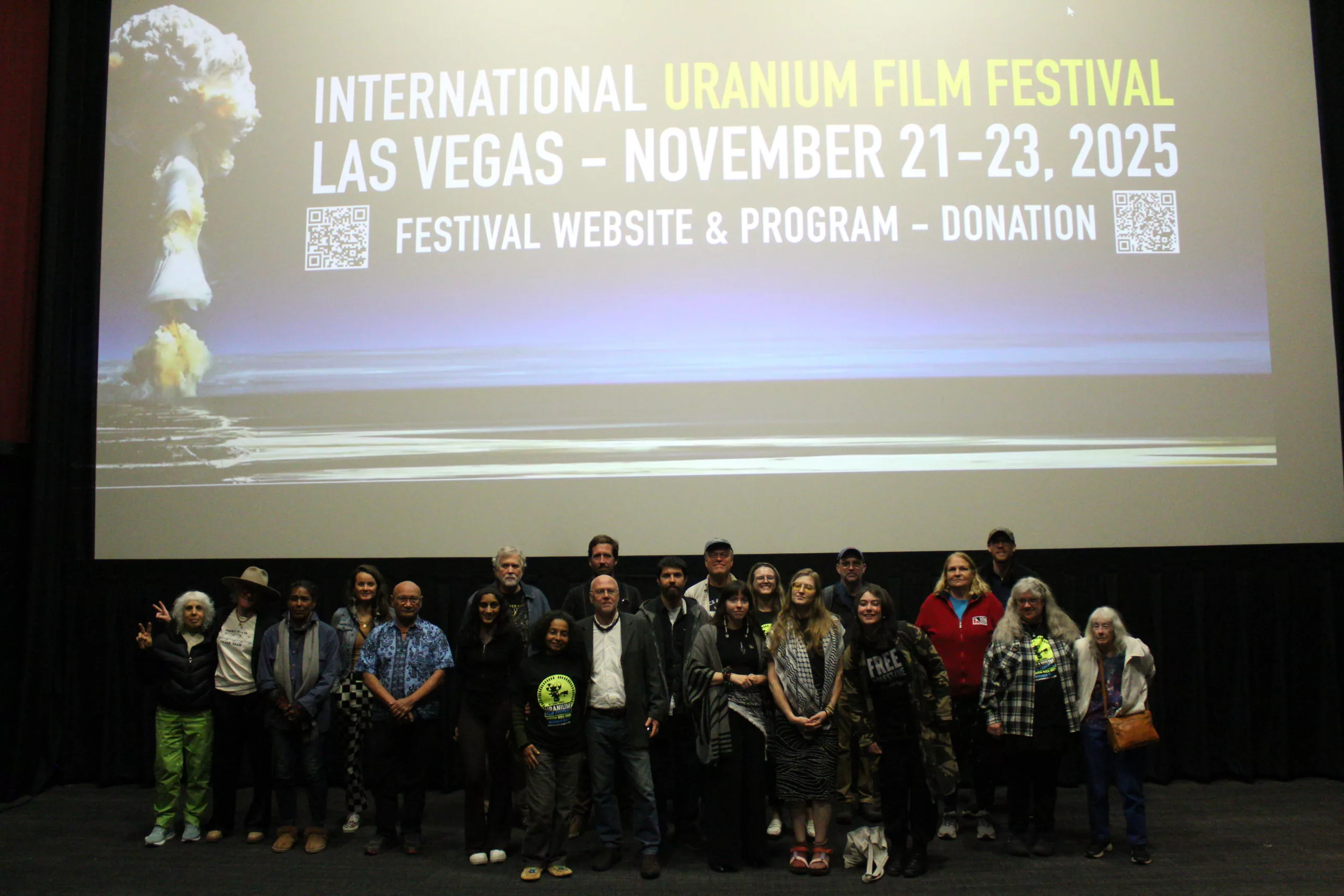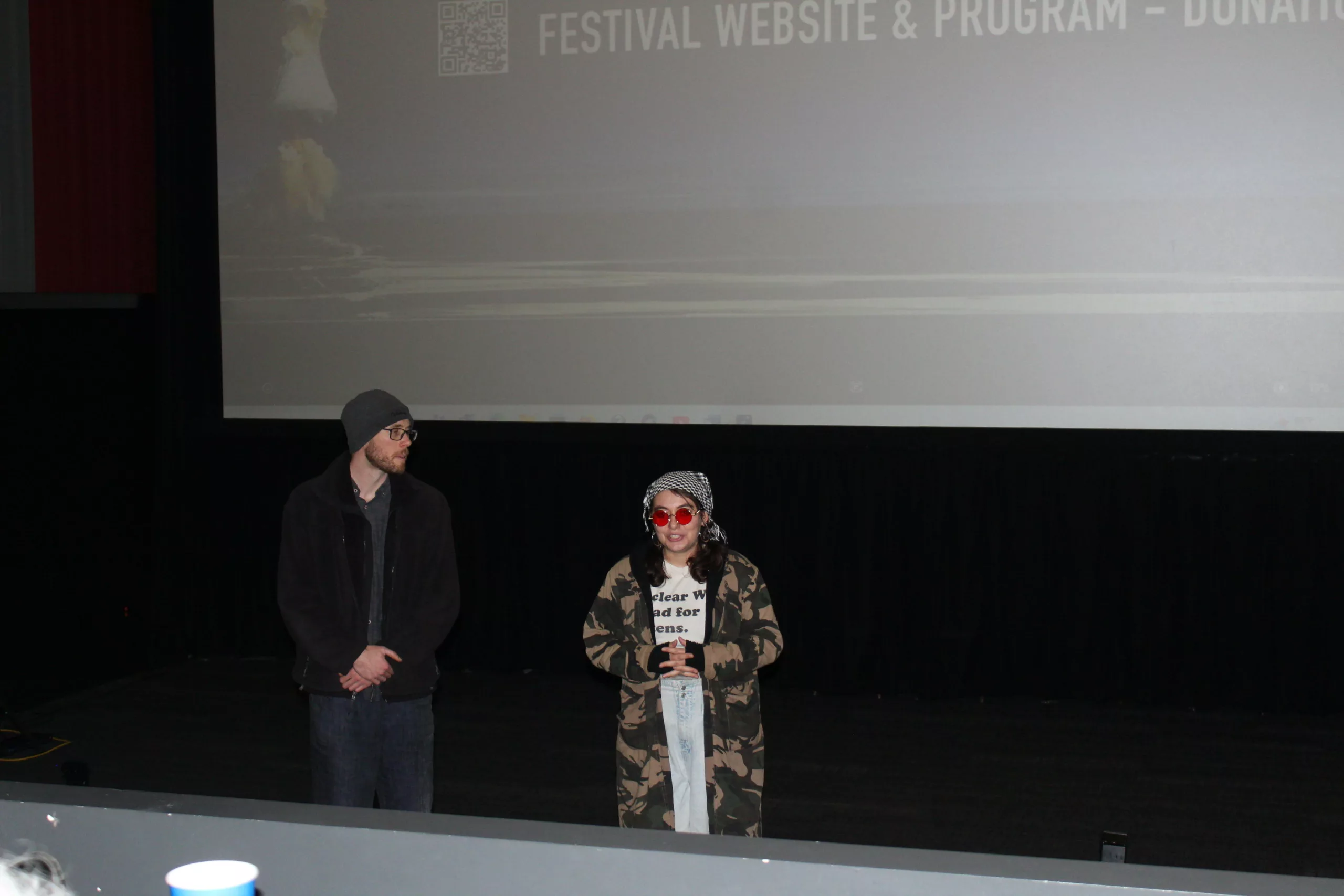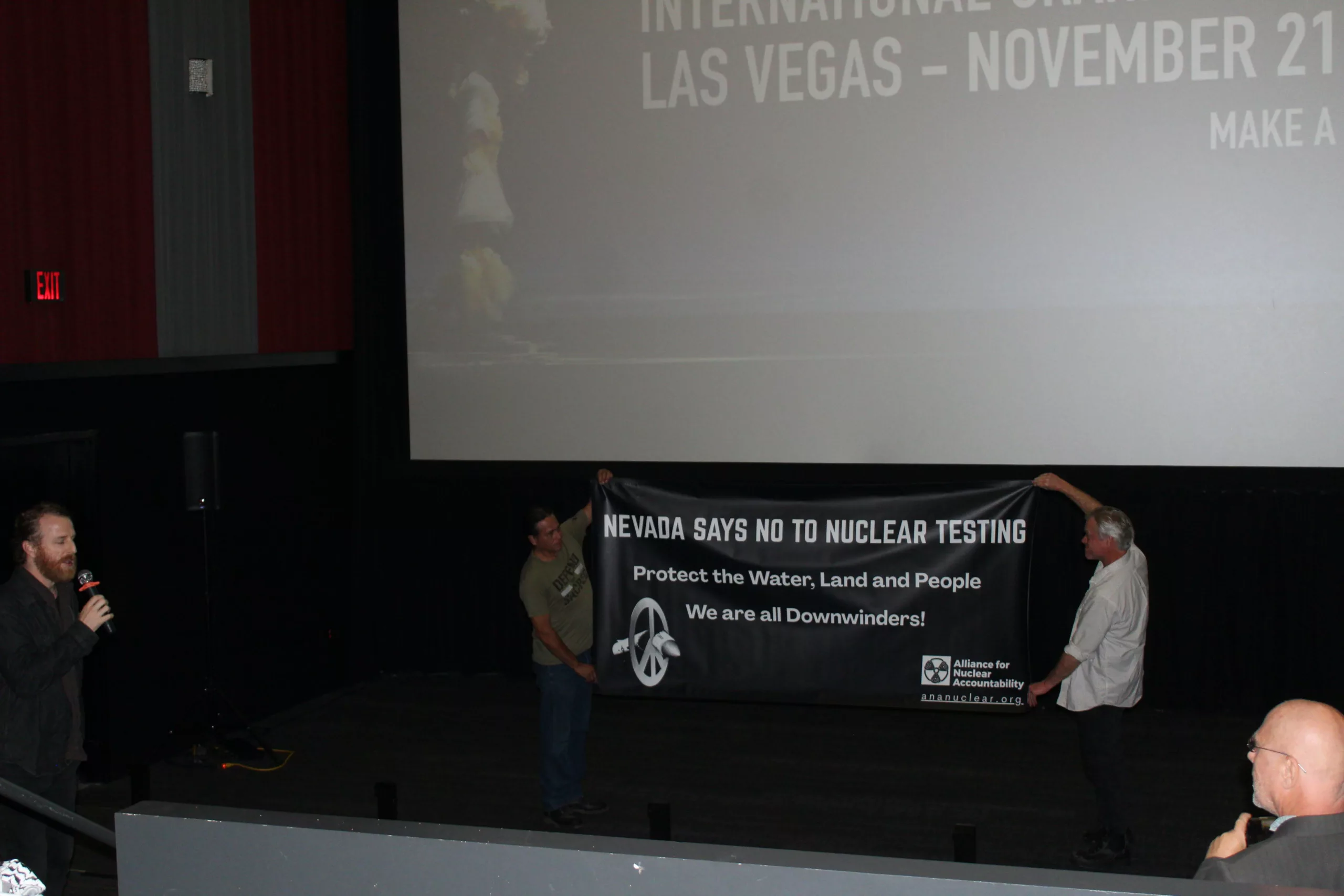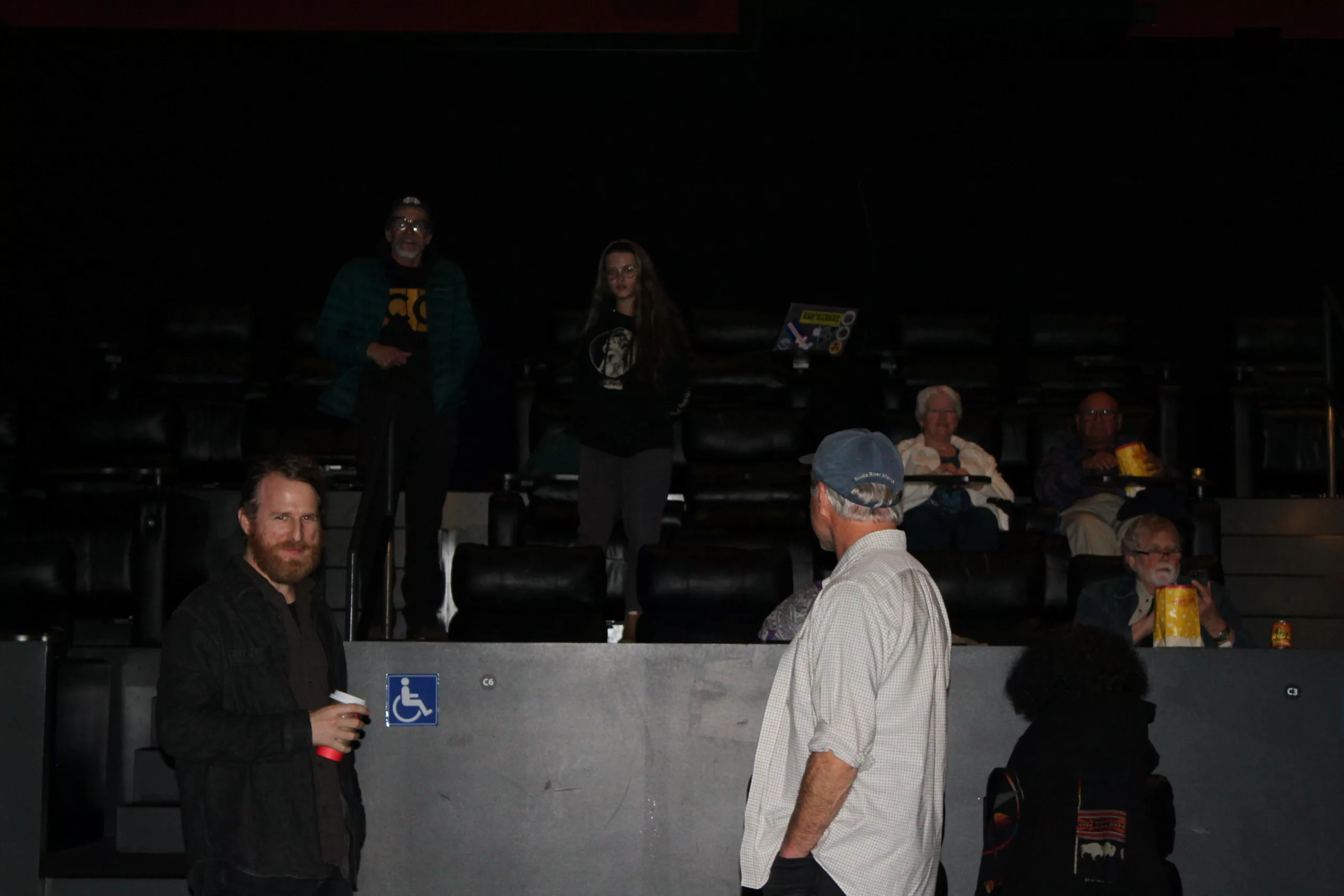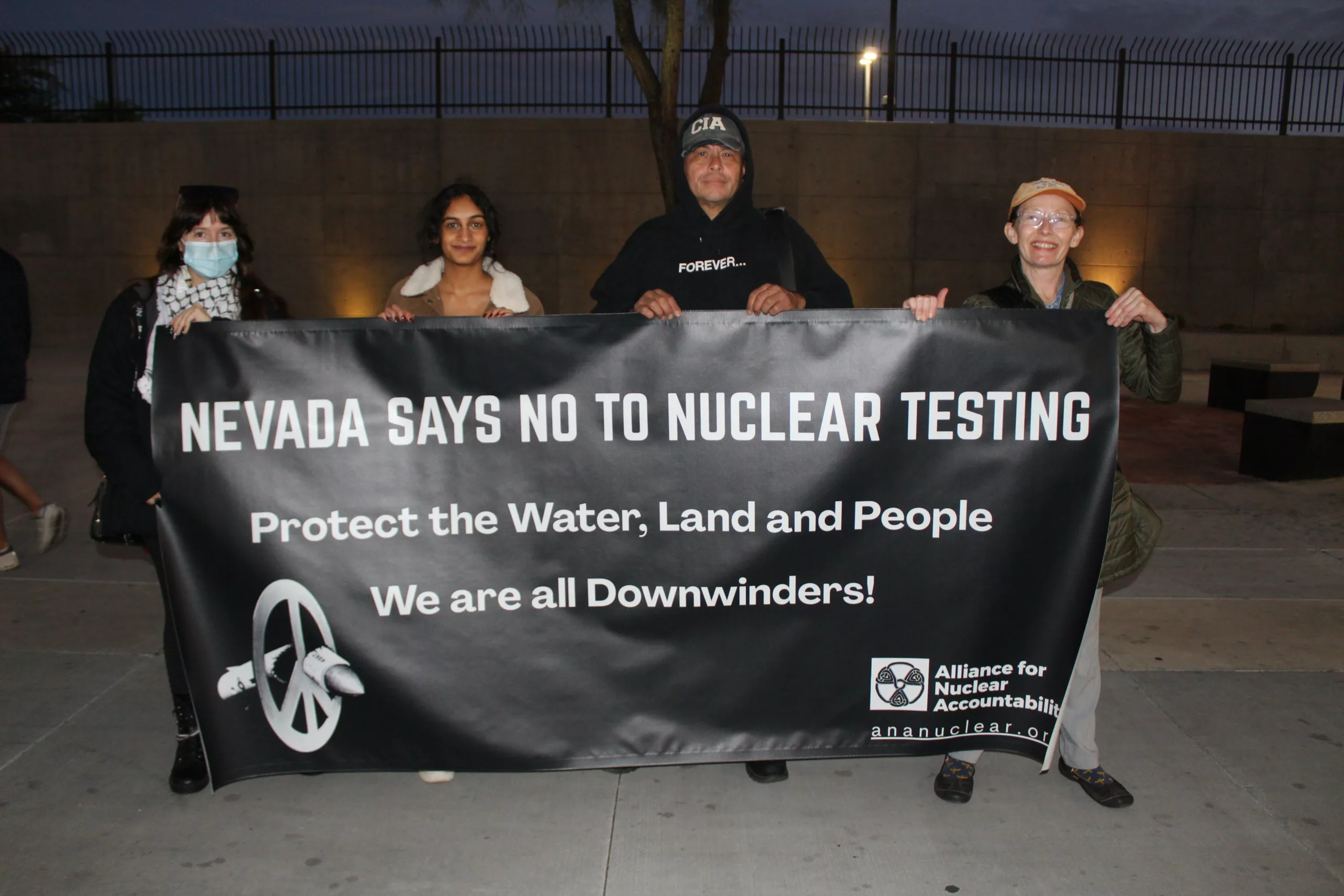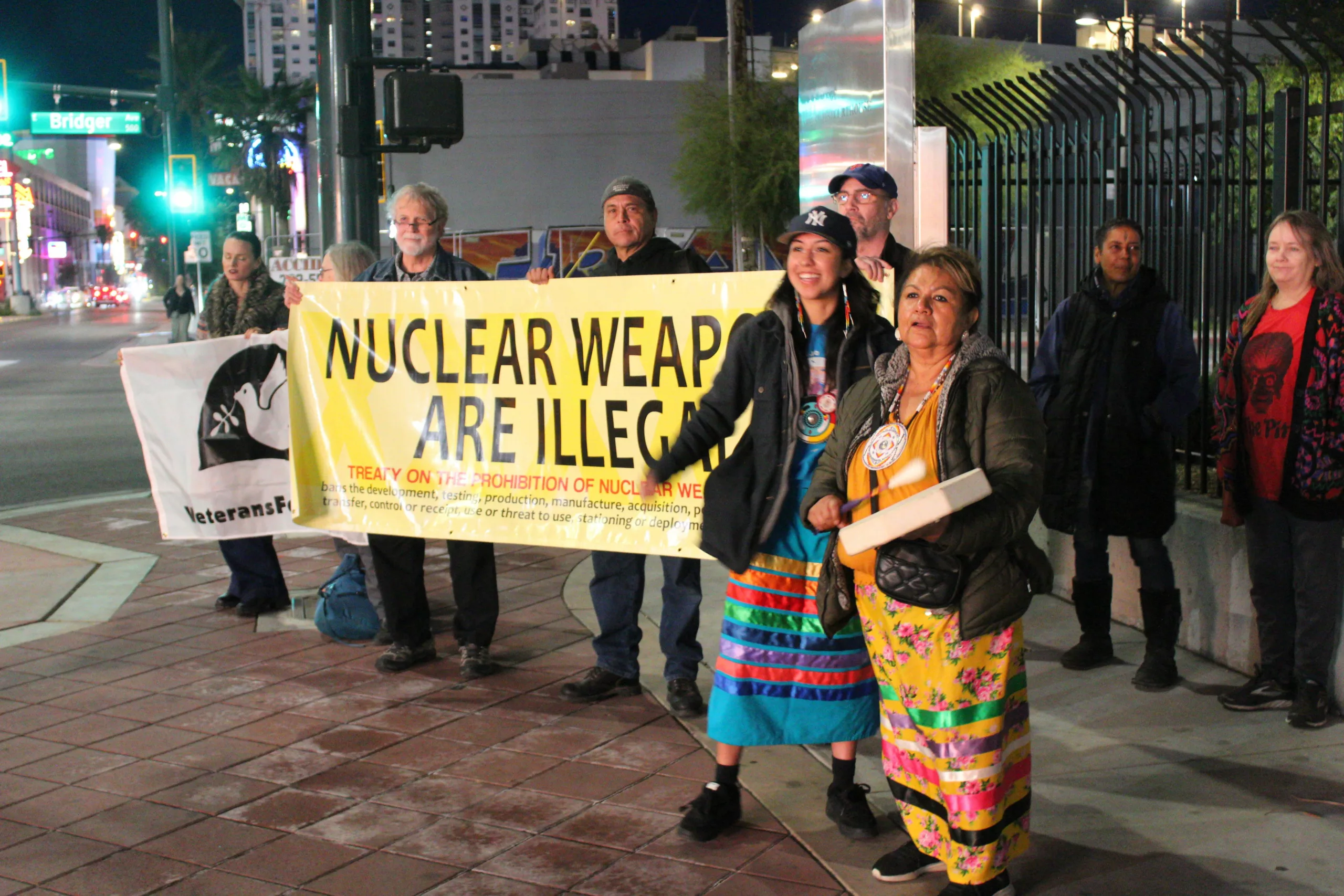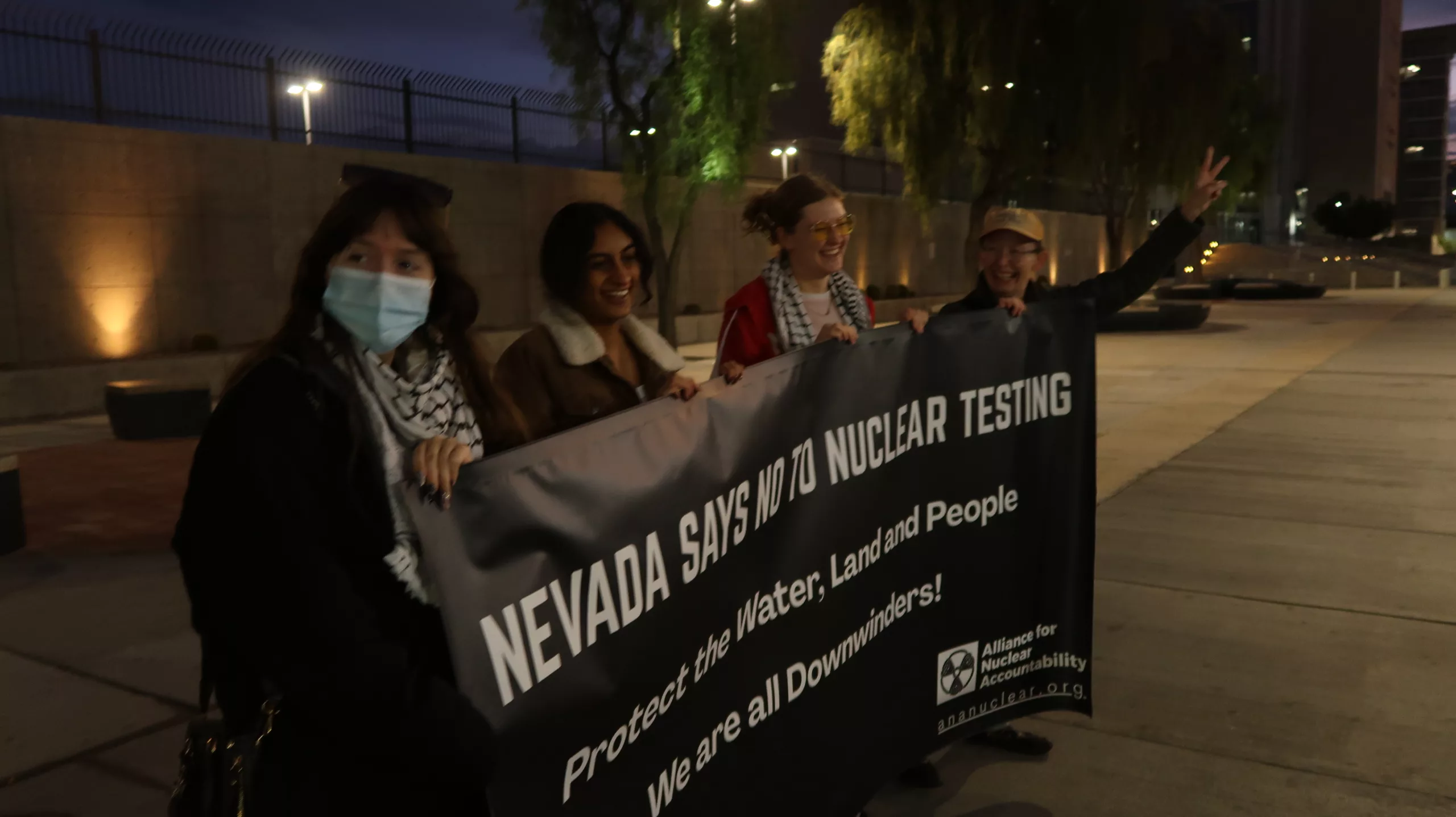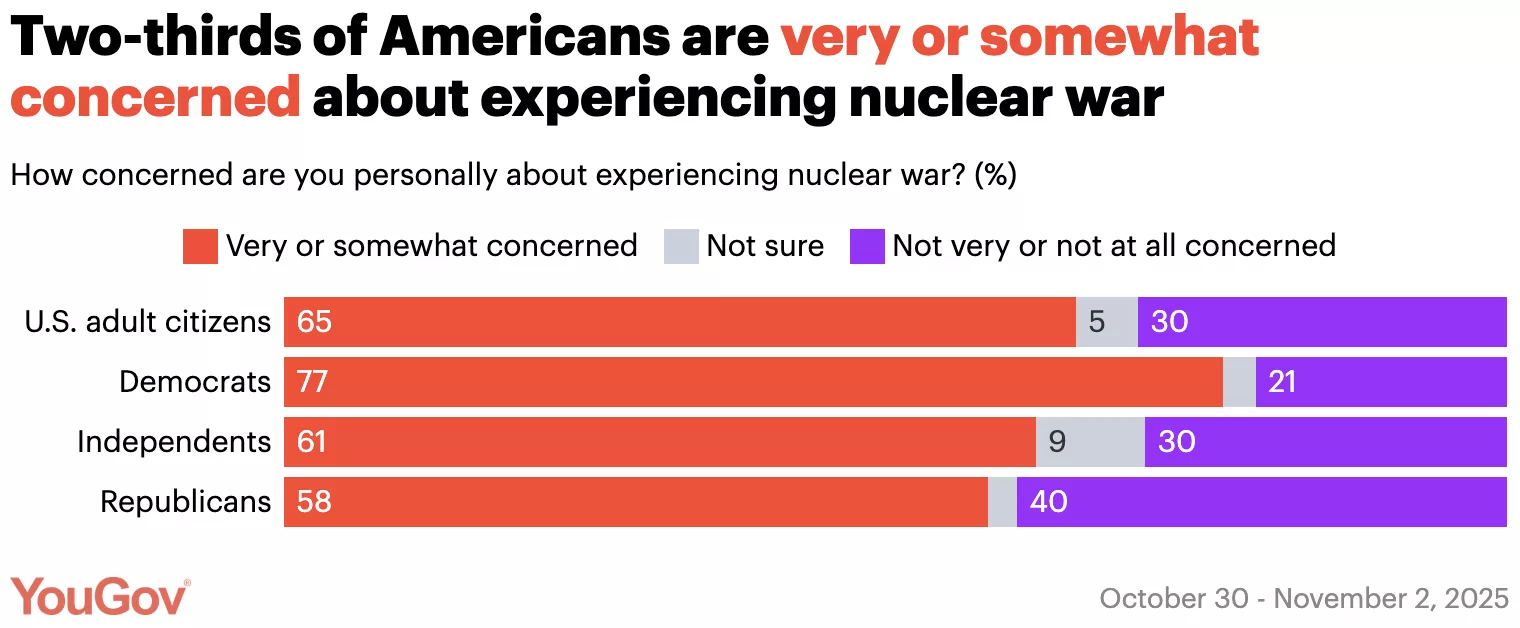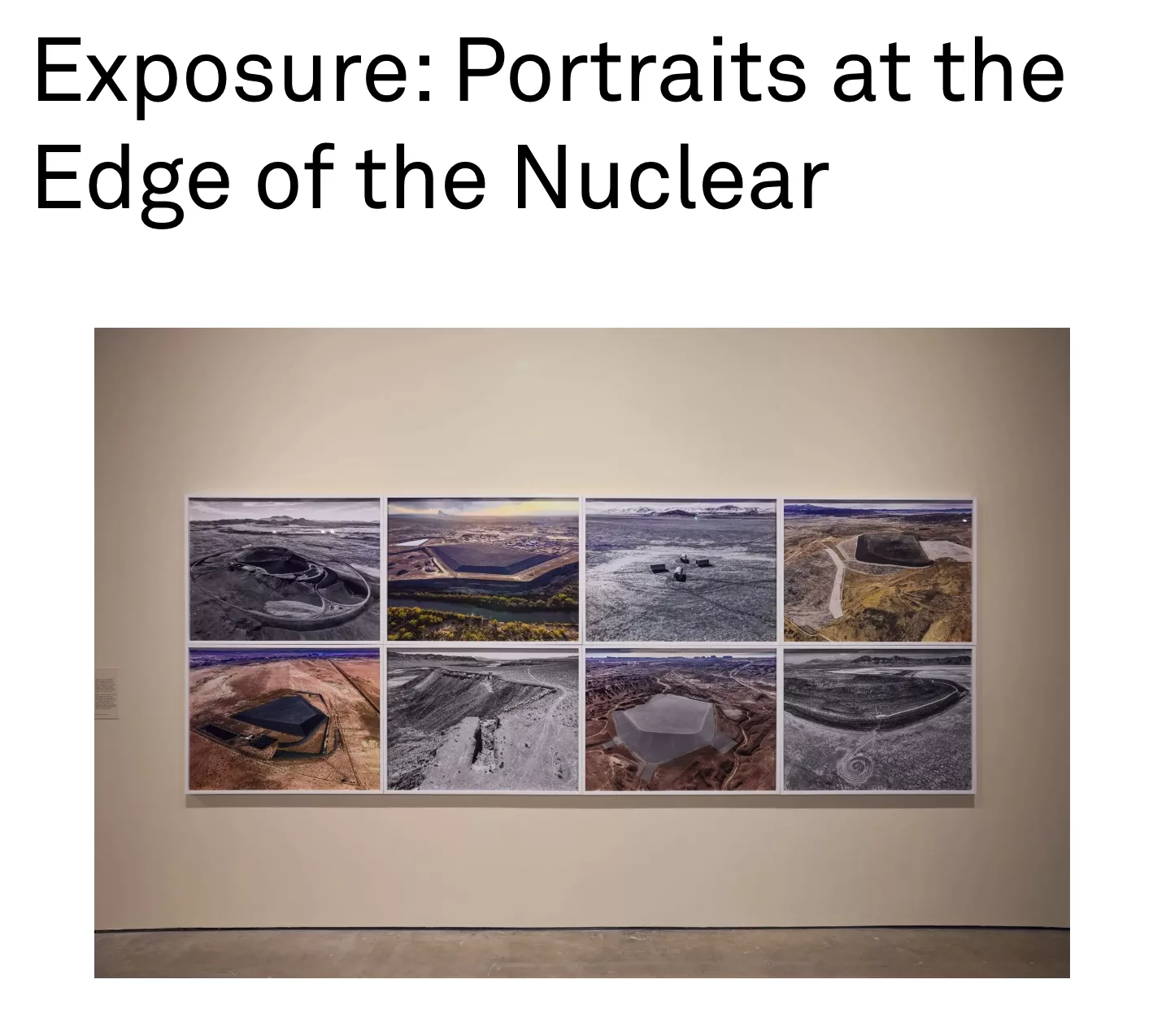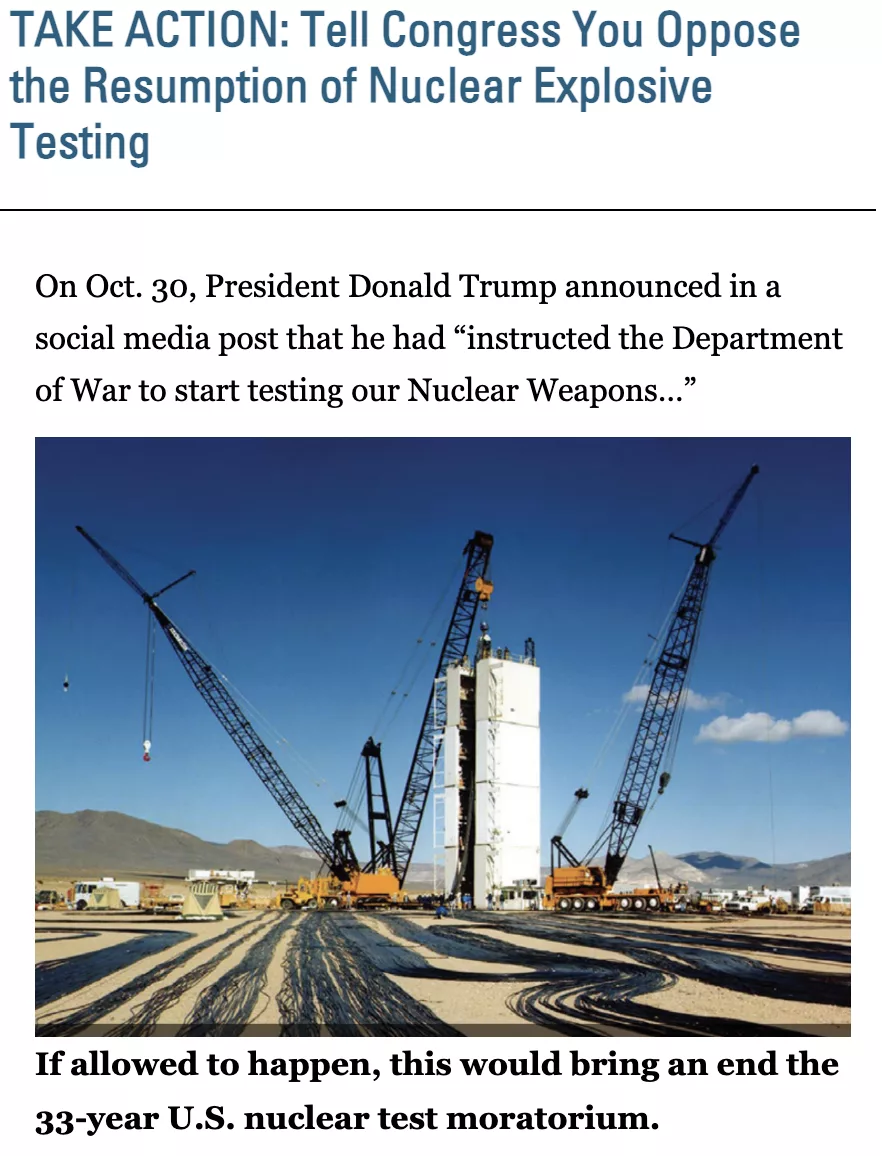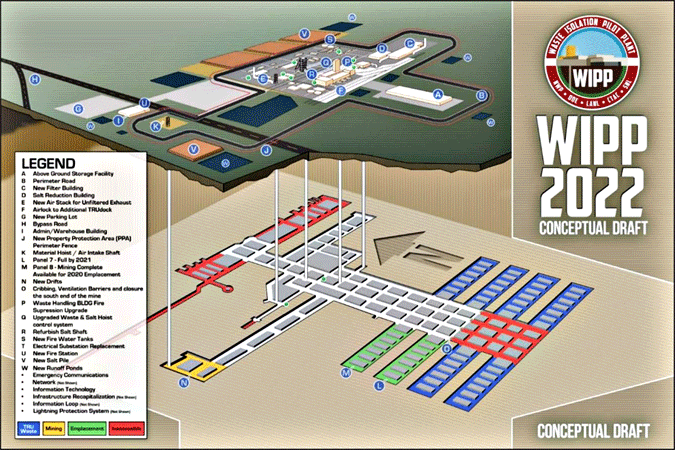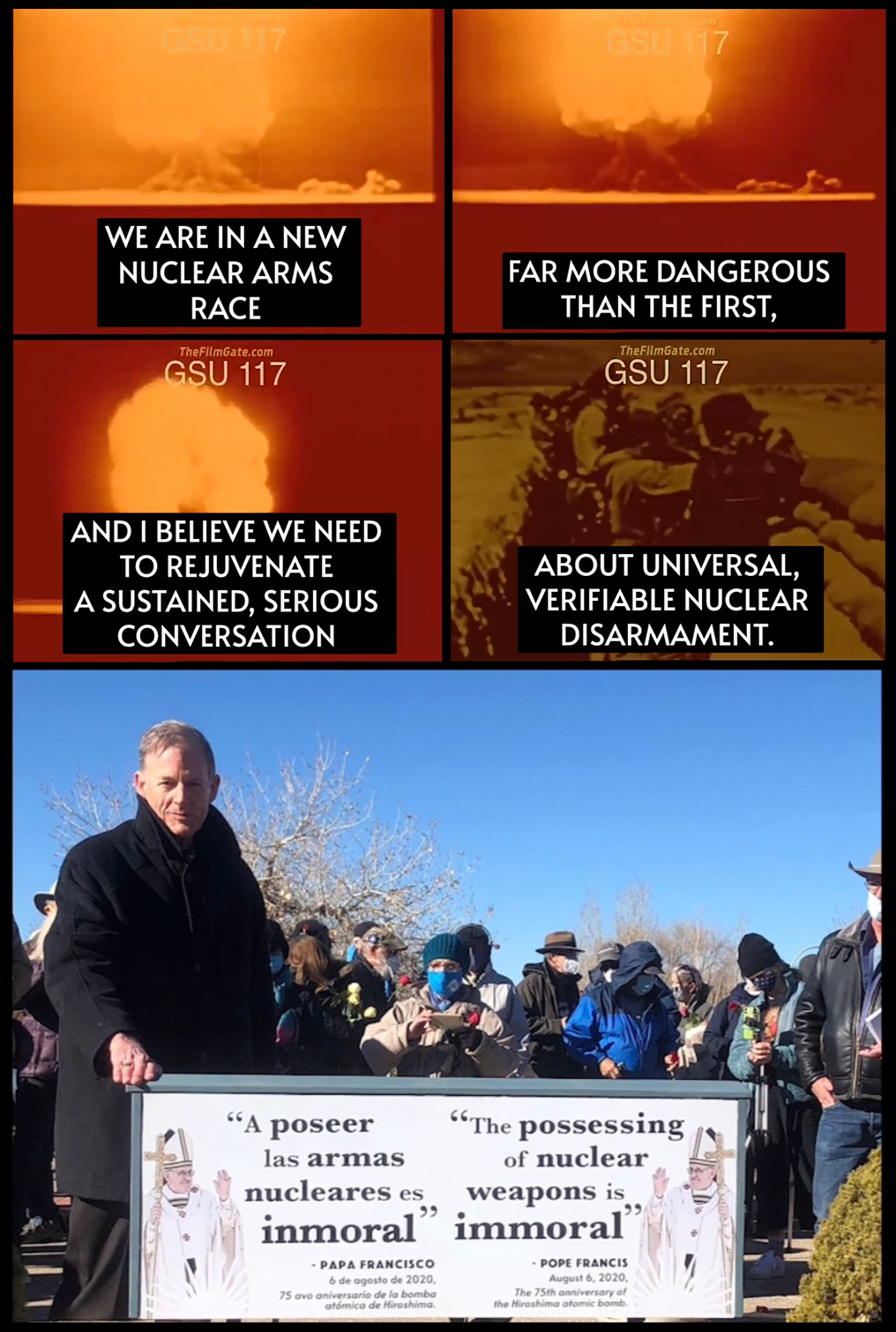QUOTE OF THE WEEK
Trump’s Talk of Nuclear Tests Recalls Fears of the Cold War
“Yes, we can learn things by nuclear testing. But when you look at the big picture, we have much more to lose by going back to testing than we have to gain.”
– SIEGFRIED S. HECKER, a former director of the Los Alamos weapons lab in New Mexico, where the first atomic bomb was created, after President Trump’s call to resume nuclear testing revived a Cold War debate. The New York Times nytimes.com
LANL’s Central Mission: Los Alamos Lab officials have recently claimed that LANL has moved away from primarily nuclear weapons to “national security”, but what truly remains as the Labs central mission? Here’s the answer from one of its own documents:
LANL’s “Central Mission”- Presented at: RPI Nuclear Data 2011 Symposium for Criticality Safety and Reactor Applications (PDF) 4/27/11
Banner displaying “Nuclear Weapons Are Now Illegal” at the entrance in front of the Los Alamos National Lab to celebrate the Entry Into Force of the Nuclear Weapon Ban Treaty on January 22, 2021
“There is nothing comparable in our history to the deceit and the lying that took place as a matter of official Government policy in order to protect this industry. Nothing was going to stop them and they were willing to kill our own people.”
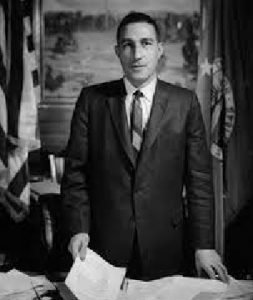
— Stewart Udall, United States Secretary of the Interior under President Kennedy and President Johnson.
He was the father of Senator Tom Udall (who ended up being a vigorous supporter of expanded nuclear weapons “modernization” plans).
Follow the Money!
Livermore FY26 Budget Request (Courtesy of Tri-Valley CAREs)
Map of “Nuclear New Mexico”
In 1985, US President Ronald Reagan and Russian President Mikhail Gorbachev declared that “a nuclear war cannot be won and must never be fought.”

NEW & UPDATED
Federal official says further testing needed to determine LANL’s chromium plume migration
“Asked about the difference in opinion between the federal and state agency regarding the sampling, Kunkle said, ‘I can’t answer why we have the disconnect,’ adding that the only sampling done at that monitoring location, called zonal sampling, ‘is really not intended to predict the long term environment or trends in the regional aquifer. That really should be done only with monthly monitoring.’”
By Clara Bates cbates@sfnewmexican.com | santafenewmexican.com
A federal official says more testing is needed to determine whether a toxic chromium plume has seeped into San Ildefonso Pueblo’s groundwater, after the state called groundwater testing “conclusive evidence” the U.S. Department of Energy’s efforts at containment have been “inadequate.”
New Mexico’s Environment Department announced last month hexavalent chromium from Los Alamos National Laboratory had migrated to Pueblo de San Ildefonso land for the first time.
But Jessica Kunkle — the Los Alamos Field Office manager with the U.S. Department of Energy — told state lawmakers on the Radioactive and Hazardous Materials Committee on Monday afternoon the type of groundwater sampling conducted may not have told the whole story. The agency is working with partners to get a monitoring well installed “as quickly as possible,” she said, to get better data.
New Air Force Chief Boosts Nuclear Buildup, Moving Away From Deterrence, Experts Warn
“Gen. Ken Wilsbach promotes nuclear “recapitalization” in his first memo to the Air Force — fueling fear of a radical shift away from nukes acting solely as deterrence.”
By: Austin Campbell, The Intercept | theintercept.com

“We will advocate relentlessly for programs like the F-47, Collaborative Combat Aircraft as well as nuclear force recapitalization through the Sentinel program and the B-21,” Wilsbach wrote in a memo dated November 3, referring to planned upgrades to nuclear missiles and stealth bombers.
Experts who spoke to The Intercept said the language signals a doctrinal pivot, prioritizing displays of strength and the buildup of nuclear weaponry over internal repair — an approach that may appeal politically to the Trump administration and Defense Secretary Pete Hegseth, but does little to ease the fatigue and distrust spreading among airmen.
…
The Sentinel program Wilsbach referenced is intended to modernize the land-based leg of the nuclear triad, with new missiles, hardened silos, and updated command-and-control infrastructure across missile fields in Wyoming, Montana, and North Dakota. It’s the Air Force’s planned replacement for aging Minuteman III intercontinental ballistic missile systems. The B-21 Raider is the next-generation stealth bomber designed to replace older strategic bombers like the B-2 and B-1, delivering both conventional and nuclear payloads.
Critics say framing these nuclear modernization efforts as “recapitalization” obscures the ethical and strategic implications of expanding U.S. nuclear capabilities amid declining morale and retention.
“You don’t ‘recapitalize’ genocidal weaponry.”
“The chief of staff’s emphasis on weaponry is disheartening. His description of nuclear weapon ‘recapitalization’ is an abomination of the English language. You don’t ‘recapitalize’ genocidal weaponry. Both the Sentinel missile program and the B-21 bomber are unnecessary systems that could cost as much as $500 billion over the next 20 years,” said William Astore, a retired Air Force lieutenant colonel and military historian.
Los Alamos National Lab (LANL) Town Hall December 3rd, 2025 – Thoughts from Nuclear Watch New Mexico:
The LANL Director mentioned Non-proliferation is a big part of their work. However, the Nuclear Nonproliferation program budget is a mere 6.5% of the total Lab budget (Nuclear Weapons is 84%, with a Billion dollar increase for FY26). https://nukewatch.org/wp-content/uploads/2025/09/FY26-Lab-Table-spreadsheets-Chart-1.pdf Nuclear Nonproliferation is a valuable program that LANL does well, and its funding should not be cut to provide more money for nuclear weapons production (literally the opposite of nonproliferation). The Nuclear Nonproliferation budget should be increased, especially if the Lab director agrees on its importance. NukeWatch NM is entirely supportive of LANL’s Sealed Sources program, which serves as the nation’s lead for collecting potentially dangerous radioactive materials that are no longer needed, securing them, and ensuring they don’t fall into the wrong hands, protecting communities and enhancing security.
On the discussion of AI missions at the lab:
The lab is partnering with NVIDIA for their hardware and ChatGPT/Open AI for their models. “The goal is to harness the power of the next evolution of high performance computing and apply it to our national security science and technology. Big development on this front is the “genesis” mission…” and in an answer to a question, want to “use artificial intelligence to [for example] help us develop the molecules that could deliver a therapeutic isotope to a cancer cell with high specificity so that when that undergoes radioactive decay the decay products basically kill the cancer cell but no surrounding tissue”
Again, the lab’s nuclear weapons budget ate up almost all else this year – how does the lab propose to work on this kind of work when its’ science budget is less than 1%? How will this advancement of AI be applied to our national security science and technology in terms of nuclear weapons? NukeWatch has serious concerns and questions regarding the tangible risks associated with integrating commercial AI infrastructure to be with active national security and nuclear defense programs. Beyond this, a $1.25 billion advanced computing campus is planned in Michigan to support far-away Los Alamos Lab in high-performance computing and AI research.
Continue reading
Nuclear Watch New Mexico Attends the Alliance for Nuclear Accountability Fall Meeting Nov. 21-23 in Las Vegas, Protesting Nuclear Testing in Nevada & Much More!
Sophie Stroud, Communications and Associate Director, represented NukeWatch at the Alliance for Nuclear Accountability's (ANA) fall meeting Nov. 21-23 in Las Vegas, hosted locally by Ian Zabarte, Principal Man of the Western Shoshone, Secretary of State of the Western Shoshone National Council, and Secretary of the Native Community Action Council (NCAC). The Nevada Test Site, now called the "Nevada National Security Site" and Yucca Mountain are both nuclear sites on Shoshone Land, and nuclear issues continue to threaten the Western Shoshone People. Yucca Mountain is Western Shoshone property with Constitutional protection, and the Department of Energy cannot prove ownership. ANA is a national network made up of 30 organizations whose members live near US nuclear bomb plants and their waste sites. The meeting was scheduled in coordination with the renowned International Uranium Film Festival — uraniumfilmfestival.org. As an organizer of the ANA Meeting as well as the International Uranium Film Festival, NCAC, composed of Shoshone and Paiute peoples, believe these films are a necessary part of the ongoing awareness, witness and resistance to nuclear war, human health and a livable Mother Earth. As 2025 marks the 80th anniversary of the first atomic bombings at the Trinity Site, Hiroshima, and Nagasaki, the world faces a new nuclear arms race that includes nuclear "modernization" of weapons, as well as the fast-tracking of uranium mining for nuclear-powered artificial intelligence data centers.
Friday morning, Nov. 21, the group traveled to the Mercury Exit gate of the Nevada Test Site with banners opposing nuclear weapons and nuclear testing. On October 29, before a meeting in South Korea with Chinese President Xi, President Donald Trump announced on social media that he “instructed the Department of War to start testing [U.S.] Nuclear Weapons on an equal basis” with Russia and China. The post contains various inaccuracies and ambiguity over whether he wants to resume underground nuclear explosive testing — an act the United States, Russia, and China have not undertaken in over 30 years — or continue testing of delivery systems.
Trump Orders Nuclear Weapons Testing for New Nuclear Arms Race
What might Project 2025 mean for N.M.? Non-nuclear cuts at national labs (Updated Dec 1, 2025)
“[The Heritage Foundation’s Project 2025] contemplates pulling funding from any work unrelated to nuclear weapons at Los Alamos National Laboratory, Sandia National Laboratories and sister facility Lawrence Livermore National Laboratory in California…in New Mexico, some say cutting the labs’ other scientific work would have a devastating economic effect on the state and could ultimately weaken the institutions as a whole.”
“It doesn’t take a nuclear physicist to realize that there could be massive layoffs if this proposal or these ideas were to reach fruition,” said Chandler, who worked in the employment arena for much of her time at the facility. “Now, that might expand the nuclear weapons program to some degree, but it’s not going to absorb the entire workforce.”
“Under the Biden administration, LANL has seen a massive growth in employment as the laboratory ramps up for its production of plutonium pits, the cores of nuclear bombs.”
By Gabrielle Porter and Alaina Mencinger gporter@sfnewmexican.com amencinger@sfnewmexican.com | Updated santafenewmexican.com
Project 2025 — the now-infamous blueprint for a conservative presidency that’s still publicly being held at arm’s length by Republican presidential candidate Donald Trump — proposes all sorts of sweeping policy recommendations, from promoting capital punishment to embracing mass deportations.
But tucked in the 922 pages of its report, “Mandate for Leadership 2025: The Conservative Promise,” is one recommendation that centers squarely on New Mexico.
Trump talk on nuke testing turns focus to New Mexico’s role in decades of blasts
Jay Coghlan, executive director of the nuclear watchdog group Nuclear Watch New Mexico, said Wright’s comments “somewhat” quelled his initial concerns about a renewed explosive nuclear testing program.
But he said claims Russia and China may be conducting small-scale tests known as hydronuclear tests — banned by the Comprehensive Nuclear Test Ban Treaty, of which the United States, Russia and China are all signatories — continue to give him pause. He fears rumors about the low-yield tests in other nations could be used to justify a domestic return to testing.
“That, in effect, would give permission to the U.S. [to resume testing],” Coghlan said. “But that would be in violation of the norm of the CTBT.”
Three decades removed from the United States’ last nuclear test, a testing regimen would likely be expensive and time-consuming to start up, Coghlan argued, and could prompt other nuclear powers to follow suit.
It seems likely Russia, at least, would: Following Trump’s post, Russian President Vladimir Putin announced if the United States resumed explosive nuclear testing, the Eastern European nation would follow.
“Then everybody else is going to do it, or virtually everybody else will do it, every other nuclear weapons power,” Coghlan said. “I could just see India and Pakistan champing at the bit to test. And then, of course, there’s North Korea and China.”
By Alaina Mencinger amencinger@sfnewmexican.com | November 30, 2025 santafenewmexican.com
It might not have as reverent a name as the Trinity Test or a litany of films made about it. But Project Gnome, a 1961 explosive nuclear test conducted near Carlsbad, is a relic of a bygone era in New Mexico and beyond.
In the 47 years between the Trinity Test and the end of the United States’ explosive nuclear testing in 1992, the nation would perform more than 1,000 such tests — more than any other nuclear nation — with most conducted in Nevada.
New Mexico might not have been the center of the nation’s testing efforts post-Trinity, which marked its 80th anniversary this year, but the state still played a role: Researchers from Sandia National Laboratories and Los Alamos National Laboratory helped design and conduct testing elsewhere, including at the Nevada Test Site and in the Marshall Islands.
Most Democrats and one-third of Republicans think it’s likely the U.S. will get into a nuclear war in the next decade
A new YouGov poll on nuclear weapons finds that nearly half of Americans believe it’s likely the U.S. will get into a nuclear war in the coming decade, and most are worried about personally experiencing a nuclear war. A majority believe nuclear weapons are making the world less safe, but opinions are mixed on whether the U.S. should dismantle all of its nuclear weapons.
By: Jamie Ballard| November 26, 2025 today.yougov.com
46% of Americans think it’s likely the U.S. will get into a nuclear war within the next 10 years; 37% think this is not very or not at all likely. 57% of Democrats and 37% of Republicans think this is likely.
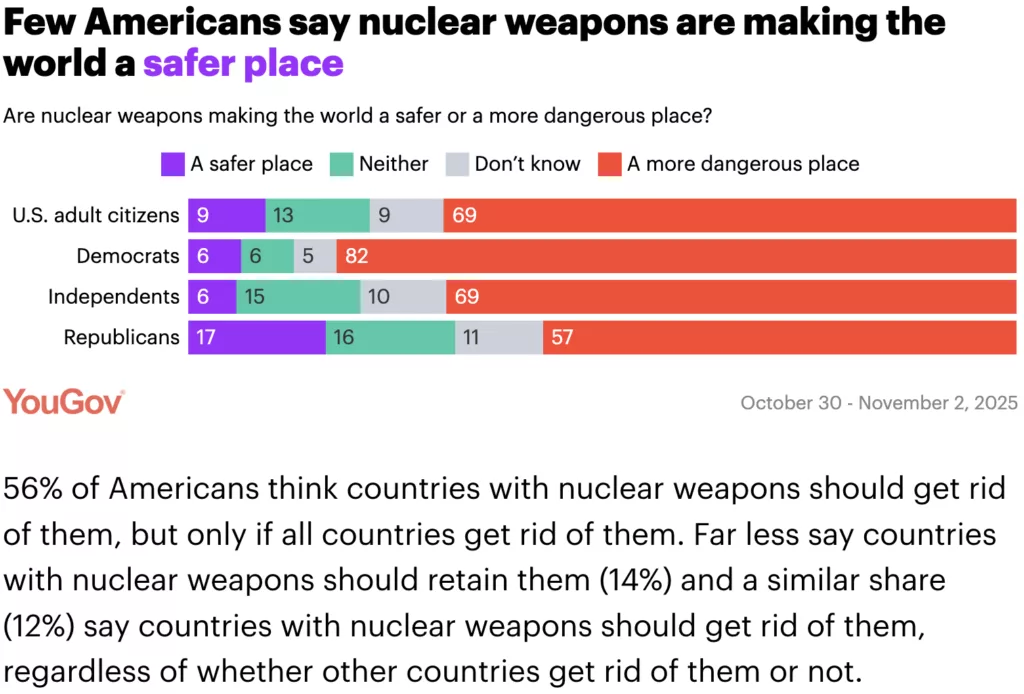
Department of Energy Seeks to Eliminate Radiation Protections Requiring Controls “As Low As Reasonably Achievable”
FOR IMMEDIATE RELEASE, November 21, 2025
Contact: Jay Coghlan, 505.989.7342, c. 505.470.3154 | Email
Santa Fe, NM – An internal Department of Energy (DOE) memorandum eliminates worker and public radiation protection rules known “As Low As Reasonably Achievable” (ALARA). This fundamental departure from decades of accepted health physics practices is being promoted by senior DOE political appointees with little background in health or radiation control. It is marked as “URGENCY: High” under the auspices of the DOE Deputy Secretary, the Under Secretary for Science, and the Administrator of the National Nuclear Security Administration. The memorandum awaits the final signature of DOE Secretary Chris Wright.
The memo’s stated goal is to:
“…remove the ALARA principle from all DOE directives and regulations, including DOE Order 458.1, Radiation Protection of the Public and the Environment, NE [Office of Nuclear Energy] Order 458.1, Radiation Protection of the Public, and, upon completion of the rulemaking process, 10 CFR [Code of Federal Regulations] 835, Occupational Radiation Protection.” [1]
It follows the playbook of the Heritage Foundation’s Project 2025, which called for:
“Set[ting] clear radiation exposure and protection standards by eliminating ALARA (“as low as reasonably achievable”) as a regulatory principle and setting clear standards according to radiological risk and dose rather than arbitrary objectives.” [2]
Department of Energy Seeks to Eliminate Radiation Protections Requiring Controls “As Low As Reasonably Achievable”
An internal Department of Energy (DOE) memorandum eliminates worker and public radiation protection rules known “As Low As Reasonably Achievable” (ALARA). This fundamental departure from decades of accepted health physics practices is being promoted by senior DOE political appointees with little background in health or radiation control. It is marked as “URGENCY: High” under the auspices of the DOE Deputy Secretary, the Under Secretary for Science, and the Administrator of the National Nuclear Security Administration. The memorandum awaits the final signature of DOE Secretary Chris Wright.
The memo’s stated goal is to:
“…remove the ALARA principle from all DOE directives and regulations, including DOE Order 458.1, Radiation Protection of the Public and the Environment, NE [Office of Nuclear Energy] Order 458.1, Radiation Protection of the Public, and, upon completion of the rulemaking process, 10 CFR [Code of Federal Regulations] 835, Occupational Radiation Protection.” [1]
It follows the playbook of the Heritage Foundation’s Project 2025, which called for:
“Set[ting] clear radiation exposure and protection standards by eliminating ALARA (“as low as reasonably achievable”) as a regulatory principle and setting clear standards according to radiological risk and dose rather than arbitrary objectives.” [2]
Lab Chromium Contamination Confirmed on San Ildefonso Pueblo Land
Comprehensive Cleanup Needed Instead of More Nuclear Weapons
FOR IMMEDIATE RELEASE, November 14, 2025
Contact: Jay Coghlan, 505.989.7342, c. 505.470.3154 | Email
Contact: Scott Kovac, 505.316.4148 | Email
Santa Fe, NM – The New Mexico Environment Department has announced:
“A toxic chromium plume from Los Alamos National Laboratory has spread beyond Lab boundaries onto Pueblo de San Ildefonso land for the first time, with contamination exceeding state groundwater standards… These new results are conclusive evidence that the U.S. Department of Energy’s efforts to contain the chromium plume have been inadequate.”
In reality, chromium groundwater contamination probably migrated beyond the LANL/San Ildefonso Pueblo boundary long ago, with past Lab maps of the plume “magically’ stopping at the border. In the past, tribal leadership has commented that it was fortunate that the contamination stopped there, but that any future indications of groundwater contamination on Pueblo land could have serious consequences. The San Ildefonso Pueblo is a sovereign Native American tribal government.
As late as the late 1990s the Lab was falsely claiming that groundwater contamination was impossible because underlying volcanic tuff is “impermeable.” [1] This ignored the obvious fact that the Parajito Plateau is heavily seismically fractured, providing ready pathways for contaminant migration to deep groundwater. By 2005 even LANL acknowledged that continuing increasing contamination of the regional aquifer is inevitable.[2] Some 300,000 northern New Mexicans rely upon the aquifer for safe drinking water. The potential serious human health effects (including cancer) caused by chromium contamination was the subject of the popular movie Erin Brockovich.
JOIN US THIS WEEKEND! 13 DEC 2025 , 11–3 PM and 14 DEC 2025 , 11–3 PM
https://www.sitesantafe.org/en/events/exposure-portraits-at-the-edge-of-the-nuclear/
Long Table Public Participatory Discussions*
*Only on Saturday and Sunday at 2 PM
Attendees are further invited to participate in The Long Table, a horizontal format for honest, open discussion based on current nuclear affairs. The Long Table is a non-hierarchical, democratic forum for public discussion. Initially devised as a creative response to conventional hierarchies of ‘expert panels’ followed by ‘audience questions’, event attendees are instead invited to both observe and contribute to the conversation. Anyone is welcome to take a seat at the table and offer their perspective.
Conversationalists at this Long Table include artist Will Wilson, Nuclear Watch New Mexico, Multicultural Alliance for a Safe Environment (MASE), Back from the Brink (BftB), and artist Shayla Blatchford of Anti-Uranium Mapping Project.
Nuclear Watch New Mexico
Through comprehensive research, public education and effective citizen action, Nuclear Watch New Mexico seeks to promote safety and environmental protection at regional nuclear facilities; mission diversification away from nuclear weapons programs; greater accountability and cleanup in the nation-wide nuclear weapons complex; and consistent U.S. leadership toward a world free of nuclear weapons.
Jay Coghlan is Executive Director of Nuclear Watch New Mexico, a nonprofit organization that watchdogs the Los Alamos National Laboratory (LANL) and the Department of Energy’s nation-wide nuclear weapons complex. He has worked successfully against radioactive incineration at LANL and through lawsuits against the Department of Energy. He prompted a 2006 independent study that concluded that plutonium pits (the fissile “triggers” of nuclear weapons) last at least a century, leading to congressional rejections of new design nuclear weapons and their production. He is now centrally engaged in fighting against the U.S. government’s most recent and serious attempt to expand plutonium pit production. He has also served as a consultant on nuclear disarmament issues to the Santa Fe Archdiocese for the last six years.
Sophie Stroud, Communications and Associate Director of Nuclear Watch New Mexico, is a rising young activist in antinuclear weapons. Her role at Nuclear Watch New Mexico includes responsibilities in programmatic direction and implementation, both in person and digitally. She has now been working with the organization for over seven years.
Los Alamos Environmental Management Cleanup Forum Wed. December 17, 5:00-7:00 p.m. MST
When: Wednesday, December 17, 5:00-7:00 p.m. MST
Where: In-person and virtual
In-person — SALA Event Center, 2551 Central Avenue, Los Alamos, NM
Virtual — Via Microsoft Teams
Microsoft Teams Need help?
Join the meeting now
Meeting ID: 296 163 029 119 48
Passcode: Yt3eU9AB
Dial in by phone
+1 323-486-1924,,694997065# United States, Los Angeles
Find a local number
Phone conference ID: 694 997 065#
Endless Nuclear Waste Storage in NM?? Not On Our Watch…
Keep up with the Stop Forever WIPP Coalition to learn how to take action against the Federal Government’s Plan to Expand WIPP and keep it open indefinitely.
Visit the Stop Forever WIPP Coalition’s website and social media:
Website: www.StopForeverWIPP.org
Facebook: facebook.com/StopfvrWIPP
Twitter: twitter.com/stopforeverwipp
Instagram: instagram.com/stopfvrwipp
Stay Informed of All Permit-Related Happenings at WIPP! Sign Up for Updates:
The New Mexico Environment Department maintains a Facility Mailing List to which you can add your name and address to get the latest information – just email Ricardo Maestas at the New Mexico Environment Department at ricardo.maestas@state.nm.us and ask to be added to the list. Or mail your request with your mailing address to:
Continue reading
Waste Lands: America’s Forgotten Nuclear Legacy
The Wall St. Journal has compiled a searchable database of contaminated sites across the US. (view)
Related WSJ report: https://www.wsj.com
New Nuclear Media: Art, Films, Books & More
A House of Dynamite review – Kathryn Bigelow’s nuclear endgame thriller is a terrifying, white-knuckle comeback
★★★★★: Amid a global arms race, ending the threat of nuclear war — and even the testing of nuclear weapons — is imperative, said the Holy See’s diplomat to the United Nations.
By Peter Bradshaw, The Guardian | September 2, 2025 theguardian.com
Kathryn Bigelow has reopened the subject that we all tacitly agree not to discuss or imagine, in the movies or anywhere else: the subject of an actual nuclear strike. It’s the subject which tests narrative forms and thinkability levels.
Maybe this is why we prefer to see it as something for absurdism and satire – a way of not staring into the sun – to remember Kubrick’s (brilliant) black comedy Dr Strangelove, with no fighting in the war room etc, rather than Lumet’s deadly serious Fail Safe.
Time Zero: 05: The Lab (Part 01)
https://964f6bfd-c857-4667-8d59-615efbd0d7c4.libsyn.com/05-the-lab-part-01
”
When the Manhattan Project arrived on the Pajarito Plateau in northern New Mexico, the land was not uninhabited. To establish the highly secretive Site Y, the United States military forcibly removed generations of Nuevomexicano ranchers and blocked regional Indigenous groups from accessing sacred sites. Almost immediately, the lab began detonating massive amounts of explosives, scarring the landscape. Military personnel regularly dumped nuclear waste into local canyon systems that ultimately flowed into the Rio Grande. When World War II came to a close, though, the lab did not.
More than eight decades later, an apocalyptic weapons factory—Los Alamos National Laboratory—still looms over the Pueblos and villages north of Santa Fe. Ninety miles south, Sandia National Laboratory and Kirtland Air Force Base store thousands of nuclear warheads beneath the city of Albuquerque. Both laboratories are expanding in scope and scale.
This week, you’ll hear from Dr. Alicia Romero, curator at the Albuquerque Museum and part of the steering commitee of the Tularosa Basin Downwinders Consortium; Yvonne Montoya, a Nuevomexicana dancer and choreographer; Dr. Myrriah Gómez, a scholar documenting nuclear colonialism in New Mexico; Joni Arends, co-founder and executive director of Concerned Citizens for Nuclear Safety; Archbishop John C Wester, of the Archiocese of Santa Fe; and members of Veterans for Peace.
Learn more, make a donation, or find a text-based version of today’s program at: timezeropod.com.
For a deep dive into the impacts of nuclear colonialism across the state of New Mexico, check out (and bookmark) Nuclear Watch New Mexico.
And visit the website of Tewa Women United to learn more about intersectional justice projects that center northern New Mexico communties.”
Thank You For All Your Support
We are living in the most dangerous times since the 1980’s. The world is in a new nuclear arms race, arguably more dangerous than the last because there are now multiple nuclear actors, new cyber and hypersonic weapons and artificial intelligence.
















